1/2024
https://www.forum.kosmonauta.net/index.php?topic=2786.msg188757#msg188757https://kosmonauta.net/2024/02/planetoidy-neo-w-2024-roku/https://theskylive.com/near-earth-objectshttps://neo.ssa.esa.int/close-approacheshttps://watchers.news/category/space/near-earth-objects/https://en.wikipedia.org/wiki/List_of_asteroid_close_approaches_to_Earth_in_2024113 przelot okazał się jednak poniżej 1 LD.
Nie tak łatwo z dużym wyprzedzeniem bardzo dokładnie udaje się określić parametry przelotu.https://www.forum.kosmonauta.net/index.php?topic=2786.msg188284#msg1882842. przelot wykryty w tym roku miał miejsce jeszcze w 2023.1)
2 2024 AD 04.01 0,93 6
2024 AD 2024-Jan-04 18:17 242,819 0.63157 0.00162 9.90
2024 AD 2024-01-04 18:14 242688 0.001622 0.631 6(5-11)*m 28.7 17.3 9.9 km/s
001 04.01.2024 ok. 19:14 CET , 2024 AD , ok. 243 000 km (0,63 LD), średnica ok. 6 m
Asteroid 2024 AD to fly past Earth at 0.6 LD on January 4Wednesday, January 3, 2024
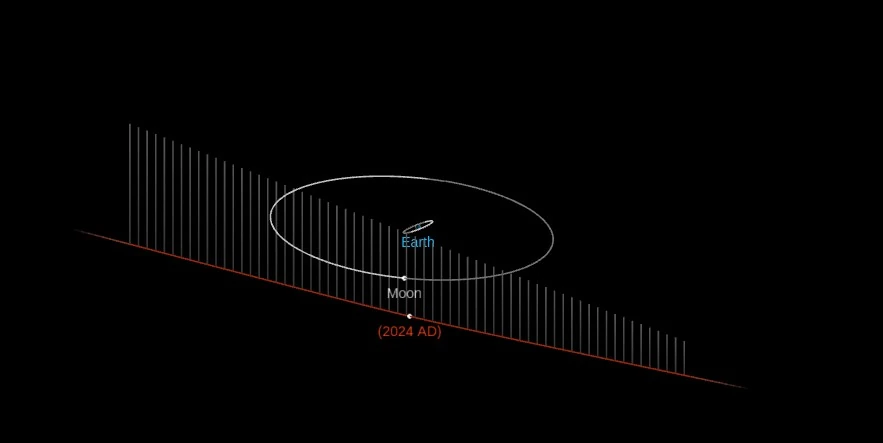
A newly-discovered asteroid designated 2024 AD will fly past Earth at a distance of 0.6 LD / 0.00162 AU (242 647 km / 150 791 miles) from the center of our planet at 18:15 UTC on January 4, 2024.
This is the first known asteroid to fly past Earth within 1 lunar distance since the start of the year. In 2023, we’ve seen 110 such flybys and 123 in 2022.
Asteroid 2024 AD was first observed at Pan-STARRS 2, Haleakala, Hawaii on January 1, 2024.
It belongs to the Apollo group of asteroids and has an estimated diameter between 4.7 and 11 m (15.4 – 36 feet).
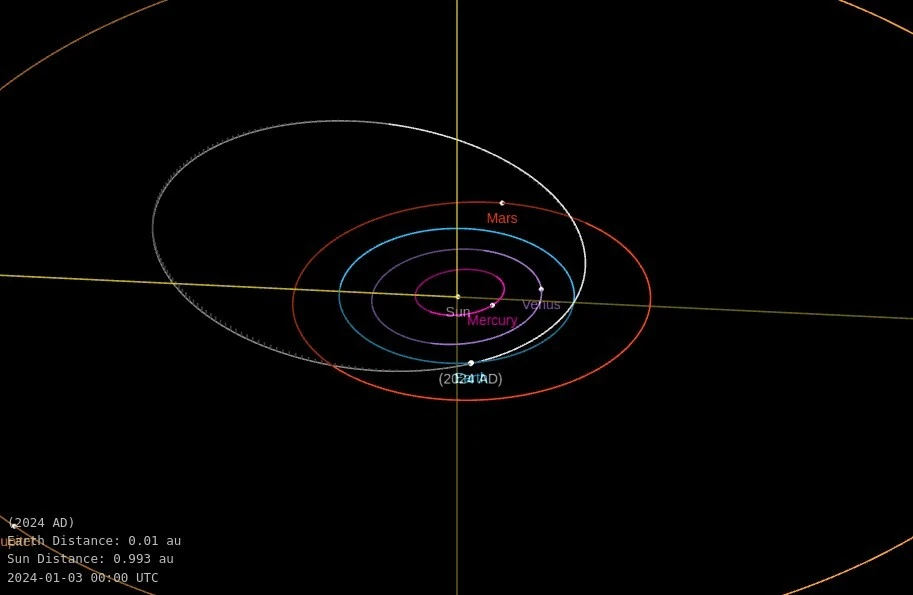
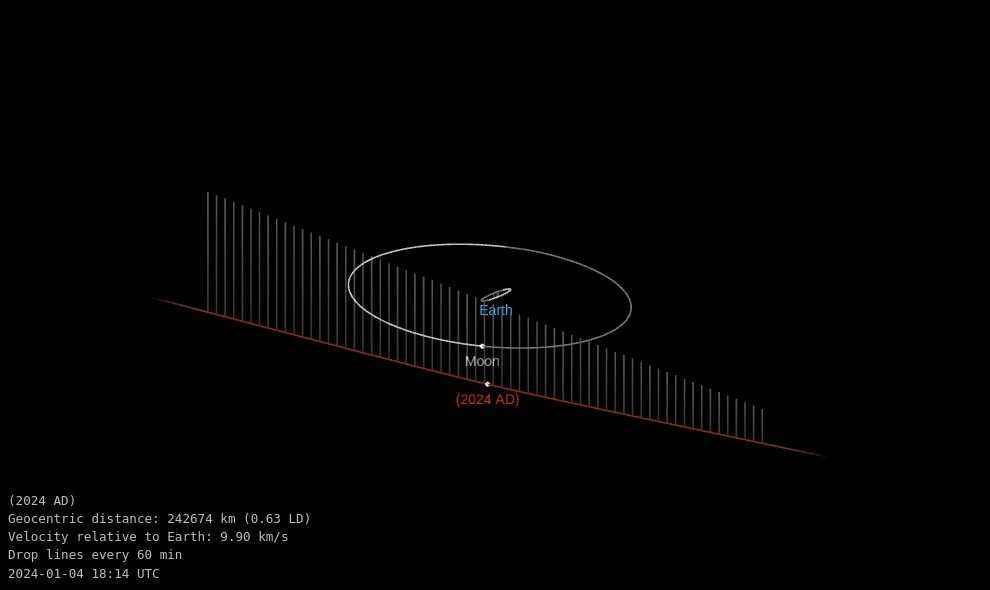 https://watchers.news/2024/01/03/asteroid-2024-ad-to-fly-past-earth-at-0-6-ld-on-january-4/
https://watchers.news/2024/01/03/asteroid-2024-ad-to-fly-past-earth-at-0-6-ld-on-january-4/2)
1 2024 AL 31.12 (2023) 0,64 10
2024 AL 2023-Dec-31 08:07 357,800 0.93064 0.00239 12.56
2024 AL 2023-12-31 08:05 357823 0.002392 0.931 11(8-18*)m 27.6 16.6 12.6 km/s 8 - 18*
002 31.12.2023 ok. 09:05 CET , 2024 AL , ok. 358 000 km (0,93 LD), średnica ok. 11 m
3)
5 2024 AZ3 14.01 0,66 6
2024 AZ3 2024-Jan-14 20:53 252,423 0.65655 0.00169 9.93
2024 AZ3 2024-01-14 20:21 248890 0.001664 0.647 4 - 10* 28.9 18.0 10.0
003 14.01.2024 ok. 15:20 CET , 2024 AZ3 , ok. 249 000 km (0,66 LD), średnica ok. 6 m
4)
3 2024 AM4 11.01 0,31 6
4 2024 AG4 11.01 0,89 7
2024 AM4 2024-Jan-11 09:50 119,466 0.31073 0.00080 3.20
2024 AG4 2024-Jan-11 21:32 340,450 0.88551 0.00228 11.97
2024 AM4 2024-01-11 09:49 119458 0.000799 0.311 5 - 11*m 28.6 17.0 3.2 km/s
2024 AG4 2024-01-11 21:31 340854 0.002278 0.887 6 - 13*m 28.3 17.2 12.0 km/s
004 11.01.2024 ok. 10:49 CET , 2024 AM4 , ok. 119 000 km (0,31 LD), średnica ok. 6 m
005 04.01.2024 ok. 22:31 CET , 2024 AG4 , ok. 341 000 km (0,89 LD), średnica ok. 7 m
5)
6 2024 BQ1 20.01 0,90 3
7 2024 BX1 21.01 impakt 1
8 2024 BJ 27.01 0,88 21
2024 BQ1 2024-Jan-20 10:25 345,215 0.89791 0.00231 6.60
2024 BX1 2024-Jan-21 00:40 774 0.00201 0.00001 33.76
2024 BJ 2024-Jan-27 17:39 353,953 0.92063 0.00237 6.34
2024 BQ1 2024-01-20 10:23 345188 0.002307 0.898 2.7 - 6*m 29.9 18.8 6.6 km/s
2024 BX1 2024-01-21 00:39 774 0.000005 0.002 0.8 - 1.7* 32.7 - 33.8 km/s
2024 BJ 2024-01-27 17:35 353817 0.002365 0.920 17 - 40*m 26.0 14.9 6.3 km/s
006 20.01.2024 ok. 11:23 CET , 2024 BQ1 , ok. 345 000 km (0,90 LD), średnica ok. 3m
007 21.01.2024 ok. 01:39 CET , 2024 BX1 , ok. 774 km (impakt), średnica ok. 1 m
008 27.01.2024 ok. 18:35 CET , 2024 BJ , ok. 354 000 km (0,92 LD), średnica ok. 21 m
Asteroid 2024 BX1 (Sar2736) impacts Earth’s atmosphere over Berlin, Germany – the 8th predicted impact on recordSunday, January 21, 2024
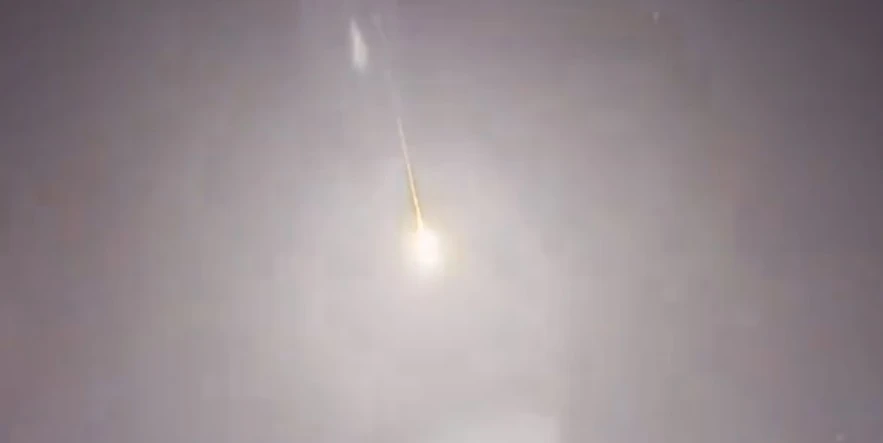
A small asteroid designated 2024 BX1 (temporary designation Sar2736) impacted Earth’s atmosphere near Berlin, Germany at 00:33 UTC on January 21, 2024. This asteroid was discovered about 3 hours before impact, making it the 8th asteroid to be discovered before impacting Earth.
The object belonged to the Apollo class of Asteroids and had an estimated diameter between 0.7 and 1.6 m (2.23 – 5.2 feet).
2024 BX1 was discovered about 150 minutes before impact by astronomer Krisztián Sárneczky at GINOP-KHK, Piszkesteto Station in Hungary.
This is the third discovery of Earth’s impactor made by Sárneczky. His previous discoveries were 2022 EB2 which impacted Earth’s atmosphere southwest of Jan Mayen island in the Arctic Ocean on March 21, 2022, and 2023 CX1 which impacted over the English Channel, between England and France on February 13, 2023.
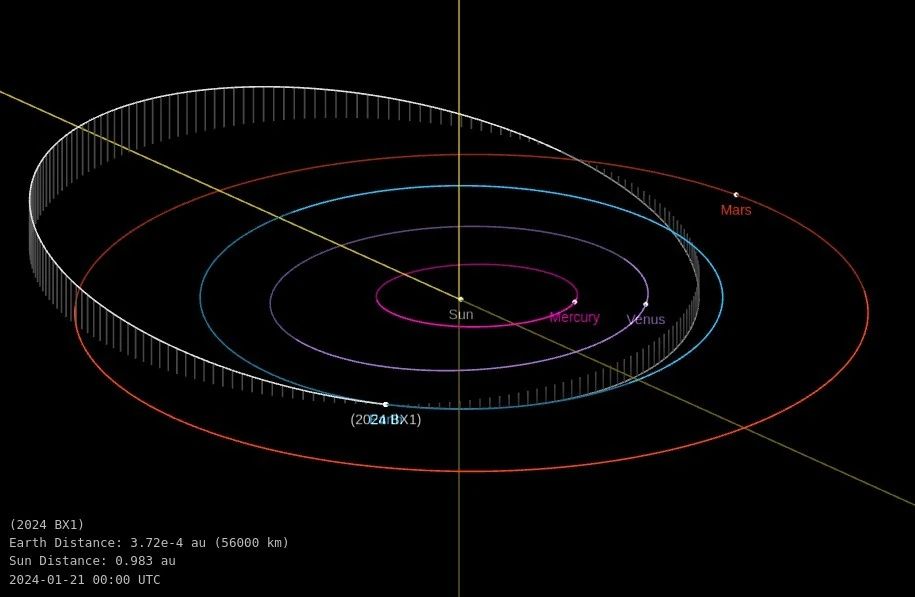
Asteroid 2024 BX1 disintegrated just west of Berlin but it’s likely some pieces of it survived the entry.
https://watchers.news/2024/01/21/asteroid-2024-bx1-sar2736-impacts-earths-atmosphere-over-berlin-germany-the-8th-predicted-impact-on-record/5)
2024 BR2 22.01 0,76 13
2024 BR2 2024-Jan-22 11:58 292,976 0.76203 0.00196 4.04
2024 BR2 2024-01-22 11:56 292986 0.001958 0.762 10 - 23*m 27.0 16.1 4.0 km/s
009 22.01.2024 ok. 12:56 CET , 2024 BR2 , ok. 293 000 km (0,76 LD), średnica ok. 13 m
6)
10 2024 CK1 08.02 0,59 5
11 2024 CJ1 09.02 0,95 7
2024 CK1 2024-Feb-08 09:29 227,778 0.59245 0.00152 12.06
2024 CJ1 2024-Feb-09 20:08 367,074 0.95476 0.00245 7.63
2024 CK1 2024-02-08 09:28 227790 0.001523 0.593 4 - 8*m 29.2 17.5 12.1 km/s
2024 CJ1 2024-02-09 20:07 367003 0.002453 0.955 6 - 12*m 28.4 17.4 7.6 km/s
010 08.02.2024 ok. 10:28 CET , 2024 CK1 , ok. 228 000 km (0,59 LD), średnica ok. 5 m
011 09.02.2024 ok. 21:07 CET , 2024 CJ1 , ok. 367 000 km (0,95 LD), średnica ok. 7 m
7)
12 2024 CY1 12.02 0,32 5
2024 CY1 2024-Feb-12 07:32 121,471 0.31595 0.00081 14.53
2024 CY1 2024-02-12 07:31 121477 0.000812 0.316 4 - 9*m 29.2 16.1 14.5 km/s
012 12.02.2024 ok. 08:31 CET , 2024 CY1 , ok. 121 000 km (0,32 LD), średnica ok. 5 m
Asteroid 2024 CY1 flew past Earth at 0.31 LDMonday, February 12, 2024
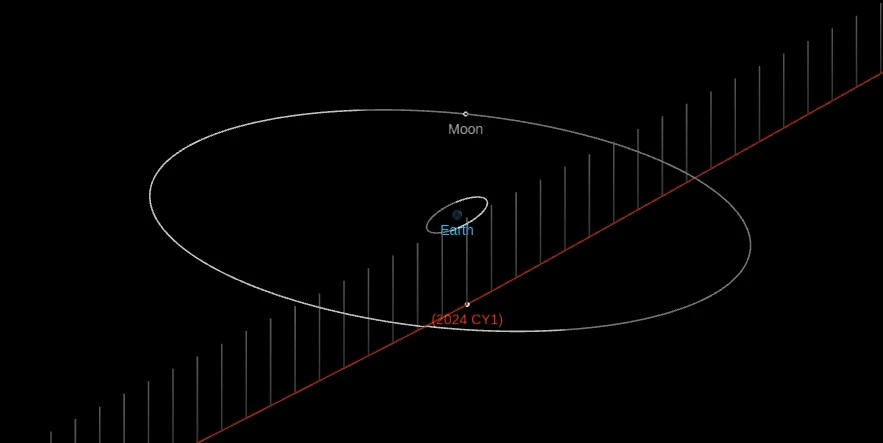
A newly-discovered asteroid designated 2024 CY1 flew past Earth at 07:24 UTC on February 12, 2024, at a distance of 0.31 LD / 0.00081 AU (121 148 km / 75 278 miles).
This is the 10th known asteroid to fly past Earth within 1 lunar distance since the start of the year and the third so far this month.
2024 CY1 was first observed at Pan-STARRS 2, Haleakala, Hawaii on February 9 — three days before its close approach.
It belongs to the Apollo group of asteroids and has an estimated diameter between 3.8 and 8.4 m (12.5 – 27.5 feet).
https://watchers.news/2024/02/12/asteroid-2024-cy1-flew-past-earth-at-0-31-ld/8 )
12 2024 CH4 11.02 0,28 10
2024 CH4 2024-Feb-11 06:10 109,045 0.28363 0.00073 24.01
2024 CH4 2024-02-11 06:09 109053 0.000729 0.284 8 - 18*m 27.6 30.7 24.0 km/s
013 11.02.2024 ok. 07:09 CET , 2024 CH4 , ok. 109 000 km (0,28 LD), średnica ok. 10 m
Asteroid 2024 CH4 flew past Earth at 0.28 LDWednesday, February 14, 2024
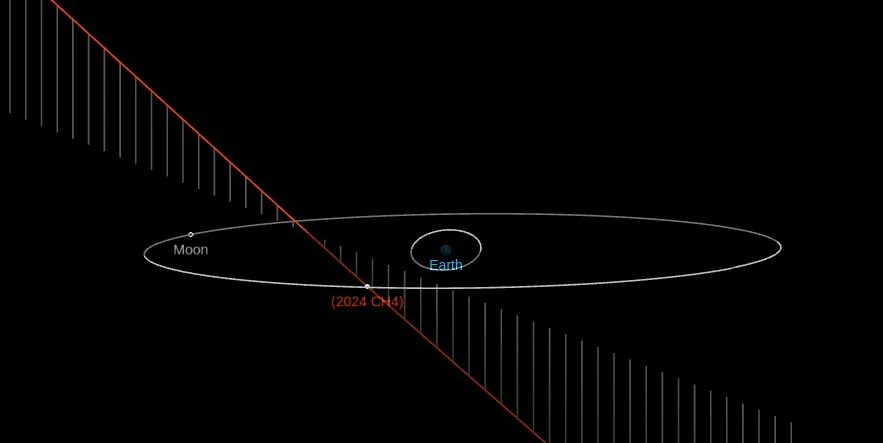
A newly-discovered asteroid designated 2024 CH4 flew past Earth at a distance of 0.28 LD / 0.0007 AU (109 004 km / 67 732 miles) at 06:10 UTC on February 11, 2024.
This is the 11th known asteroid to fly past Earth within 1 lunar distance since the start of the year.
2024 CH4 was first observed at JPL SynTrack Robotic Telescope in Auberry, one day after it made its close approach to Earth.
The object belongs to the Apollo group of asteroids and has an estimated diameter between 7.8 and 17 m (25.6 – 55.6 feet).
https://watchers.news/2024/02/14/asteroid-2024-ch4-flew-past-earth-at-0-28-ld/9)
15 2024 CM5 12.02 0,36 7
2024 CM5 2024-Feb-12 15:42 140,291 0.36490 0.00094 10.76
2024 CM5 2024-02-12 15:41 140292 0.000938 0.365 6 - 13*m 28.2 14.7 10.8 km/s
014 12.02.2024 ok. 16:41 CET , 2024 CM5 , ok. 140 000 km (0,36 LD), średnica ok. 7 m
10)
2024 BA16 15.01 0,36 5
16 2024 CT6 16.02 0,94 5
17 2024 CF7 17.02 0,28 4
2024 CT6 2024-Feb-16 21:24 359,648 0.93545 0.00240 20.94
2024 CF7 2024-Feb-17 05:12 105,880 0.27539 0.00071 10.61
2024 CT6 2024-02-16 21:22 359635 0.002404 0.936 4 - 9*m 29.1 18.3 20.9 km/s
2024 CF7 2024-02-17 05:11 105866 0.000708 0.275 4 - 8*m 29.3 16.3 10.6 km/s
015 15.01.2024 ok. NN:NN CET , 2024 BA16 , ok. 140 000 km (0,36 LD), średnica ok. 5 m
016 16.02.2024 ok. 22:22 CET , 2024 CT6 , ok. 360 000 km (0,94 LD), średnica ok. 5 m
017 17.02.2024 ok. 06:11 CET , 2024 CF7 , ok. 106 000 km (0,28 LD), średnica ok. 4 m
Asteroid 2024 CF7 to fly past Earth at 0.28 LDFriday, February 16, 2024
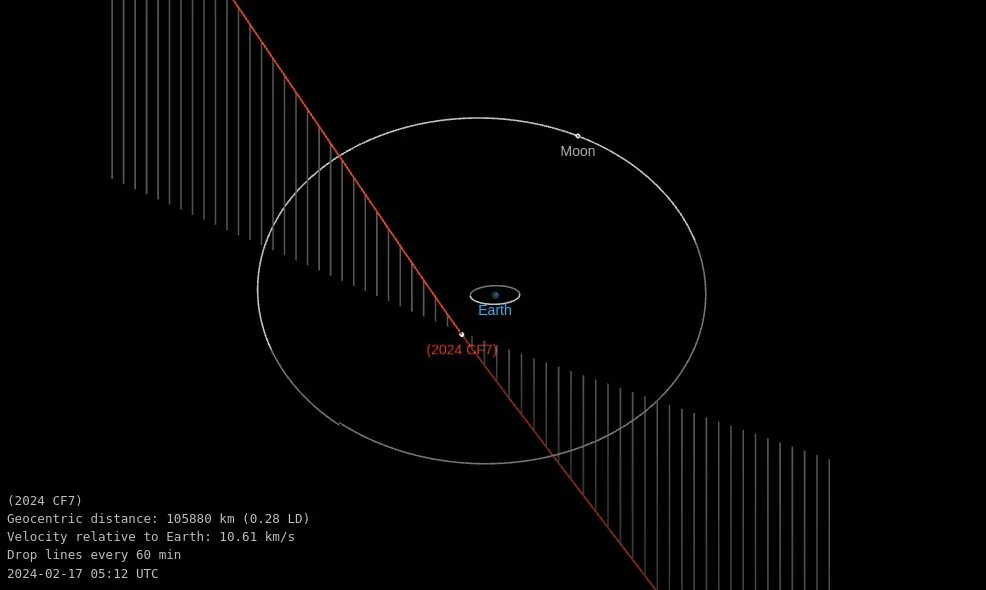
A newly-discovered asteroid designated 2024 CF7 will fly past Earth at a distance of 0.28 LD / 0.00071 AU (105 880 km / 65 791 miles) at 05:12 UTC on February 17, 2024.
This is the 14th known asteroid to fly past Earth within 1 lunar distance since the start of the year.
It was first observed at Mt. Lemmon Survey on February 15, two days before its close approach.
2024 CF7 belongs to the Apollo group of asteroids and has an estimated diameter of 3.5 – 7.8 m (11.5 – 25.6 feet).
https://watchers.news/2024/02/16/asteroid-2024-cf7-to-fly-past-earth-at-0-28-ld/11)
18 2024 DY 18.02 0,45 5
19 2024 DW 22.02 0,58 14
2024 DY 2024-Feb-18 15:25 171,132 0.44512 0.00114 11.74
2024 DW 2024-Feb-22 04:36 224,457 0.58381 0.00150 17.91
2024 DY 2024-02-18 15:24 171076 0.001144 0.445 4 - 9* 29.0 17.1 11.7
2024 DW 2024-02-22 04:32 224352 0.001500 0.584 11 - 25* 26.9 15.0 17.9
018 18.02.2024 ok. 16:24 CET , 2024 DY , ok. 171 000 km (0,45 LD), średnica ok. 5 m
019 22.02.2024 ok. 05:32 CET , 2024 DW , ok. 224 000 km (0,58 LD), średnica ok. 14 m
12)
20 2024 EF 04.03 0,15 6
2024 EF 2024-Mar-04 07:02 57,680 0.15003 0.00039 8.63
2024 EF 2024-03-04 07:00 57655 0.000385 0.150 5 - 10*m 28.8 13.7 8.6 km/s
020 04.03.2024 ok. 08:00 CET , 2024 EF , ok. 58 000 km (0,15 LD), średnica ok. 6 m
https://twitter.com/tony873004/status/176439466737715246313)
21 2024 EL3 11.03 0,09 6
2024 EL3 2024-Mar-11 10:31 36,170 0.09408 0.00024 13.71
2024 EL3 2024-03-11 10:30 36167 0.000242 0.094 5 - 11*m 28.7 26.1 13.7 km/s
021 11.03.2024 ok. 11:30 CET , 2024 EL3, ok. 36 000 km (0,09 LD), średnica ok. 6 m
14)
22 2024 EJ4 13.03 0,07 4
2024 EJ4 2024-Mar-13 17:22 26,246 0.06827 0.00018 8.68
2024 EJ4 2024-03-13 17:21 26244 0.000175 0.068 4 - 8*m 29.3 12.1 8.7 km/s
022 13.03.2024 ok. 18:21 CET , 2024 EJ4, ok. 26 000 km (0,07 LD), średnica ok. 4 m
15)
23 2024 ER4 17.03 0,42 11
2024 ER4 2024-Mar-17 09:14 161,891 0.42108 0.00108 8.30
2024 ER4 2024-03-17 09:12 161898 0.001082 0.421 9 - 21*m 27.3 15.8 8.3 km/s
023 17.03.2024 ok. 10:12 CET , 2024 ER4, ok. 162 000 km (0,42 LD), średnica ok. 11 m
16)
21 2023 FC1 10.03 0,87 10
2024 FC1 2024-03-10 14:57 334004 0.002233 0.869 8 - 18*m 27.6 16.6 5.7 km/s
024 10.03.2024 ok. 15:57 CET , 2024 FC1, ok. 334 000 km (0,87 LD), średnica ok. 10 m
17)
25 2024 FO3 26.03 0,36 10
2024 FO3 2024-03-26 12:35 136563 0.000913 0.355 8 - 18*m 27.6 14.6 10.4 km/s
025 26.03.2024 ok. 13:35 CET , 2024 FO3, ok. 137 000 km (0,36 LD), średnica ok. 10 m
18)
26 2024 GD 26.03 0,83 35
2024 GD 2024-03-26 01:04 321109 0.002146 0.835 29 - 70*m 24.8 12.9 11.5 km/s
026 26.03.2024 ok. 02:04 CET , 2024 GD, ok. 321 000 km (0,83 LD), średnica ok. 35 m
19)
27 2024 FQ5 31.03 0,09 2
2024 FQ5 2024-03-31 15:31 32623 0.000218 0.085 1.8 - 4*m 30.8 15.5 8.6 km/s
027 31.03.2024 ok. 17:31 CEST , 2024 FQ5, ok. 32 623 km (0,09 LD), średnica ok. 2 m
20)
28 2028 GV2 09.04 0,28 5
29 2024 GX3 10.04 0,19 4
30 2024 GJ2 11.04 0,05 3
2024 GV2 2024-Apr-09 04:17 107,573 0.27980 0.00072 4.72
2024 GX3 2024-Apr-10 08:27 71,560 0.18613 0.00048 10.17
2024 GJ2 2024-Apr-11 18:30 18,674 0.04857 0.00012 14.38
2024 GV2 2024-04-09 04:15 107566 0.000719 0.280 4 - 9*m 29.1 14.5 4.7 km/s
2024 GX3 2024-04-10 08:25 71552 0.000478 0.186 3 - 7*m 29.6 16.0 10.2 km/s
2024 GJ2 2024-04-11 18:29 18674 0.000125 0.049 2.4 - 5*m 30.2 13.1 14.4 km/s
028 09.04.2024 ok. 06:15 CEST , 2024 GV2, ok. 108 000 km (0,28 LD), średnica ok. 5 m
029 10.04.2024 ok. 10:25 CEST , 2024 GX3, ok. 71 000 km (0,19 LD), średnica ok. 4 m
030 11.04.2024 ok. 20:29 CEST , 2024 GJ2, ok. 18 674 km (0,05 LD), średnica ok. 3 m
21)
29 2024 GW4 09.04 0,42 6
28 2024 GY4 09.04 0,33 4
33 2024 GZ5 15.04 0,18 3
2024 GW4 2024-Apr-09 04:07 163,316 0.42479 0.00109 12.12
2024 GZ5 2024-Apr-15 16:47 68,619 0.17848 0.00046 5.04
2024 GW4 2024-04-09 04:05 163290 0.001092 0.425 5 - 10*m 28.8 15.3 12.1 km/s
2024 GY4 2024-04-09 12:07 126260 0.000844 0.328 3 - 8*m 29.4 17.4 9.3 km/s
2024 GZ5 2024-04-15 16:46 68626 0.000459 0.179 2.5 - 6*m 30.1 15.0 5.0 km/s
031 09.04.2024 ok. 06:05 CEST , 2024 GW4, ok. 163 000 km (0,42 LD), średnica ok. 6 m
032 09.04.2024 ok. 14:07 CEST , 2024 GY4, ok. 126 000 km (0,33 LD), średnica ok. 4 m
033 15.04.2024 ok. 18:46 CEST , 2024 GZ5, ok. 69 000 km (0,18 LD), średnica ok. 3 m
22)
34 2024 HA 15.04 0,04 2
2024 HA 2024-Apr-16 17:42 15,555 0.04046 0.00010 19.46
2024 HA 2024-04-16 17:41 15556 0.000104 0.040 1.2 - 2.7*m 31.7 14.5 19.5 km/s
034 16.04.2024 ok. 19:42 CEST , 2024 HA , ok. 15 556 km (0,04 LD), średnica ok. 2 m